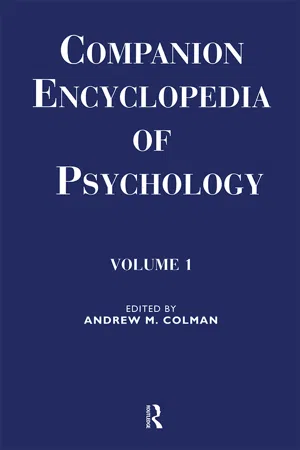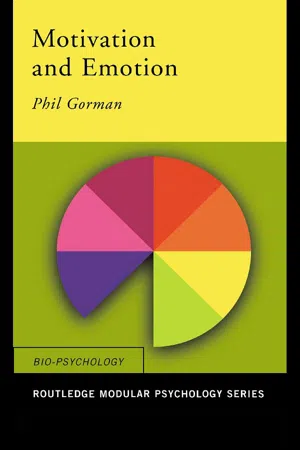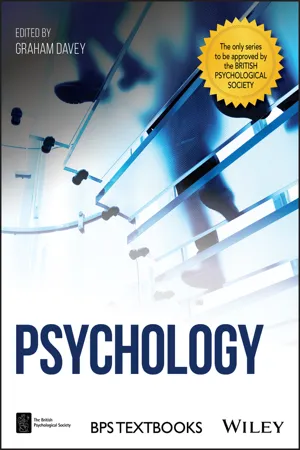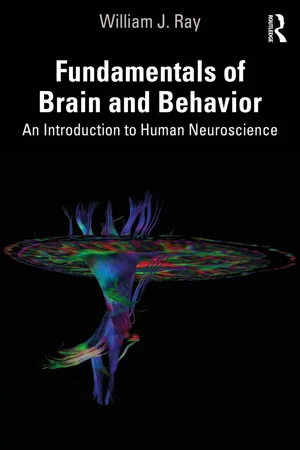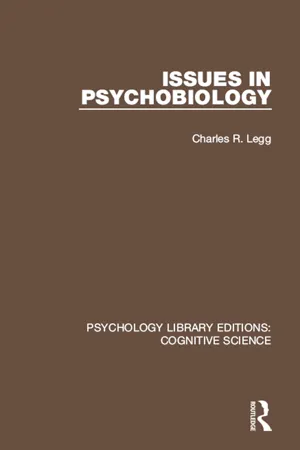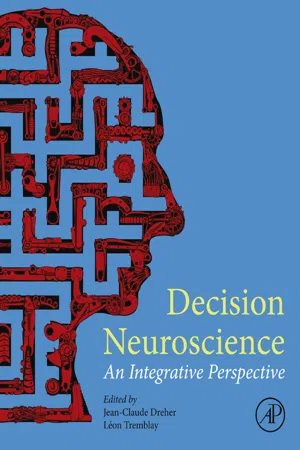Psychology
Hunger Motivation
Hunger motivation refers to the drive to satisfy the body's physiological need for food. It is influenced by biological factors such as hunger hormones and the body's energy needs, as well as psychological factors like food preferences and eating habits. Hunger motivation plays a crucial role in regulating eating behavior and maintaining the body's energy balance.
Written by Perlego with AI-assistance
Related key terms
Related key terms
1 of 4
Related key terms
1 of 3
12 Key excerpts on "Hunger Motivation"
- eBook - ePub
Companion Encyclopedia of Psychology
Volume One
- Andrew M. Colman(Author)
- 2018(Publication Date)
- Routledge(Publisher)
In order to generate a clear understanding of hunger and appetite, one major task is to define their relationships with environmental happenings, physiological states, and objectively measured food consumption. Initially, it is necessary to define the terms. Although the reader may discover some disagreement among scientists about the precise meanings of the terms, the following descriptions provide working definitions.Appetite can refer to the sum total of processes influencing the expression of the willingness to eat. Appetite is the global phenomenon influenced by cultural, economic, physiological, and cognitive factors. Hence it is appropriate to speak about the regulation of appetite and to consider the factors that influence this regulation. It is not necessary to use appetite in any more precise technical sense.The logical status of the term hunger needs clarification, for it is clear that the term is used in more than one sense by psychologists. On the one hand, hunger is a motivational construct with the logical status of a mediating concept or intervening variable (Royce, 1963). That is, the term refers to an explanatory principle which is inferred from other directly observable and measurable events. In this sense the term helps in understanding the motivational processes. On the other hand, hunger may be used to refer to certain conscious sensations or feelings linked to a desire to obtain and eat food. This is the sense in which lay people understand the notion of hunger. It is necessary to emphasize the distinction between the psychological process of hunger with relevance for motivational theory, on the one hand, and the conscious sensation of hunger on the other. It is these hunger sensations that probably exert motivational pressure on behaviour, and it is these that researchers attempt to capture by means of rating scales and other devices.Throughout this chapter, the term hunger will be used to represent a subjective experience or feeling that is associated with the desire to eat and obtain food. From a functional point of view, hunger achieves a purpose as that nagging, irritating feeling whose presence constantly serves to stimulate thoughts about food and eating. Hunger can also be present as a latent disposition which becomes activated in the presence of food stimuli. Hunger is therefore useful and reminds us that the body needs food. In this way hunger can be seen to possess a clear biological function. - eBook - ePub
Motivation
Biological, Psychological, and Environmental
- Lambert Deckers(Author)
- 2022(Publication Date)
- Routledge(Publisher)
Cummings et al., 2004 ). In one experiment, Wren and co-researchers (2001) injected ghrelin into the bloodstream of one group of participants and saline (placebo) into another group. To determine the effects of ghrelin, participants rated their hunger and then were provided a buffet lunch. The results indicated that participants given ghrelin reported greater hunger and ate more than participants given saline. In addition, prior to their lunch, ghrelin participants also indicated that they would eat more. The idea here is that the biological entity ghrelin motivates eating.Mind as a Source
Motivation can be attributed to the mind and psychological processes while ignoring the body and brain. In this case, the motivation process is considered psychological with little regard for any biological underpinnings. Internal psychological sources of motivation were traditionally divided into two varieties: drives and psychological needs. Drive, on the one hand, was created by depriving an animal of some necessary substance, such as water, food, or environmental stimulation. These deprivations resulted in thirst drive, hunger drive, and a curiosity drive, respectively. Longer periods of deprivation defined stronger drives. For example, 12 hours of food deprivation results in a stronger hunger drive than does 8 hours of deprivation. Psychological needs, on the other hand, are assumed to already exist at different intensities in individuals. Psychological questionnaires or scales are used to indicate the intensity of psychological needs, much like stepping on a bathroom scale indicates a person's weight. With such an approach, Henry Murray (1938) used his Psychological Insights Test to measure the intensity of various psychological needs. For instance, he defined the need to affiliate as approaching others with affection and remaining loyal to them. To measure the intensity of this need, rate yourself from –3 (below average) to +3 (above average) - eBook - ePub
- Philip Gorman(Author)
- 2004(Publication Date)
- Routledge(Publisher)
3 Motivation and the brain: hunger
Hunger How do we know we are hungry? Why don’t we eat ourselves to death? The role of the hypothalamus Obesity Anorexia nervosa Chapter summaryHunger
Some of the questions which need to be answered in relation to these processes include: Why do we eat? When do we eat? What do we eat? Why do some people eat more/less than others?The study of motivation based around physiological drives is particularly influential in the study of behaviour which satisfies physical drives such as eating and drinking. This chapter specifically considers the role of the brain in the identification, initiation and cessation of our drive to eat.It may seem reasonably obvious why people eat (because they are hungry), but it is perhaps not so clear what it is that makes us feel hungry; what we feel hungry for; why we eat when we do, and what it is that makes us stop eating once we start.It is not enough to simply claim that we eat because we are hungry or that we stop eating because we are ‘fiill’. There are a variety of ways that our bodies respond to our need for food. In the same way as a car will respond to its needs in a variety of ways, so the body will respond to its need for food with more than just a rumble.A car will show a number of signs that it is not getting enough petrol, it is not getting the right kind of oil or it is running low on other necessary fluids. Some of these signs will be obvious and easy to recognise (the car stops running), others will be subtler (such as rust). In relation to the human body, this might be equivalent to the obvious signs of lethargy, or the subtler appearance of white dots under our fingernails. - eBook - ePub
- Nancy Fenton, Jessica Flitter, Jessica Flitter(Authors)
- 2015(Publication Date)
- Research & Education Association(Publisher)
Maslow’s hierarchy of needs is important because of the practical applications associated with basic biological and safety needs being met before individuals can pursue the higher level needs. Individuals living in war-torn areas who are concerned for their personal safety and with providing food for themselves and their families are unlikely to be motivated to pursue achievement or self-actualization. Maslow’s theory is also valuable because it provides a general starting point for discussing human motivation, but there are many significant criticisms of his approach. Evidence supporting Maslow’s idea that individuals proceed through the hierarchy of needs in the same order has not been found, and the abstract concept of self-actualization has proven difficult to measure. Furthermore, the hierarchy of needs does not explain why some individuals choose to sacrifice meeting lower level needs in order to pursue others, such as skipping a meal in order to spend time talking with friends, or why individuals choose to risk their own safety for the thrill of skydiving. Each level in the hierarchy of needs is presented in Figure 10.2.STUDY TIPFigure 10.2. Maslow’s Hierarchy of Needs STUDY TIPBe able to identify the five levels of Maslow’s hierarchy of needs in order and provide an example of each need.Be able to compare and contrast the various motivational theories in terms of strengths and weaknesses. See Table 10.1Table 10.1. A Comparison of Motivational TheoriesHunger MotivationA key human motivation studied by psychologists is hunger , or the motivation for all animals to engage in behaviors aimed at obtaining food and nutrition. The opposite of hunger is satiety , or the feeling of being full and not hungry that results in decreasing the likelihood that an individual will be motivated to eat. On the surface, Hunger Motivation is merely a basic biological drive necessary for survival, yet there is evidence that hunger is influenced by psychological and cultural factors as well. As a consequence, hunger is often used to illustrate how both nature and nurture interact within one type of human motivation.STUDY TIPRemember the term satiety by associating it with the word satisfied . Satiety involves the general feeling of being full or satisfied that decreases the likelihood that a person will be motivated to eat.Biological Factors Impacting HungerComplex biological factors combine to influence feelings of hunger, including stomach contractions, hormones in the bloodstream, and signals from the brain. Researchers Cannon and Washburn investigated the role of stomach contractions in signaling hunger. Washburn, a graduate student at the time, swallowed a balloon that was then inflated inside his stomach, which recorded and measured stomach contractions. Washburn signaled when he was hungry by pressing a button and a high positive correlation was discovered between feelings of hunger and stomach contractions. However, defining hunger in terms of stomach pangs alone is incomplete, because individuals who have had their stomachs removed still report hunger. - eBook - ePub
- Graham C. Davey, Graham C. Davey(Authors)
- 2018(Publication Date)
- Wiley(Publisher)
In addition, men’s and women’s brains may respond differently to food. Del Parigi and colleagues (2002) placed 22 men and 22 women in a positron emission tomography scanner. Scans were conducted after people had fasted and also when they were full. There was some similarity in terms of brain activation; however, men showed more activity in the frontotemporal and paralimbic regions after fasting. Differences also emerged when brain activity was examined when people were full – women showed significantly greater activity in the sensory association areas and in the dorsolateral prefrontal cortex, while men showed more activity in the ventromedial prefrontal cortex. Del Parigi et al. (2002) interpreted this to indicate that men and women exhibit differential emotional and cognitive reactions to eating.Drawing the biological mechanisms together
To summarize, a number of mechanical, chemical, and brain signals convey information that influences our motivation to start and to stop eating. These signals all interact to control our appetite – for example, our brain detects the levels of chemicals that are released when we digest food and the hormones that are released in response to food, and the brain then processes this information in a way that influences our eating behaviours by generating feelings of either hunger or satiety.Eating as a behaviourAs well as the basic physiological processes that we have just discussed, other factors can also influence our motivation to eat. Figure 5.7 shows some of the basic physiological factors, higher-level psychological processes, and sociocultural influences that affect eating behaviour. For example, at some point in our lives, all of us have had our appetite levels influenced by psychological factors. For instance, have you ever been through a relationship breakup and found yourself eating lots of comfort foods such as crisps, biscuits, and ice cream? Many people can relate to this experience. Psychological research has documented that our mood can have a big influence on our eating – when people are more stressed, they feel more motivated to eat, hungrier, and less able to restrict what they eat (Groesz et al., 2012).Some of the diverse biological, psychological, and sociocultural factors that can influence eating behaviour.FIGURE 5.7Eating disorders: What happens when things go wrong with hungerThe obesity epidemic
We have just outlined how our mood can make us overeat. However, there are a number of other factors that can lead to us overeating. If overeating occurs in a situation in which we are not exercising enough to burn off these extra calories, we can become overweight and obese. To be classed as overweight, an individual must have a body mass index (BMI) - eBook - ePub
- David Booth(Author)
- 2016(Publication Date)
- Taylor & Francis(Publisher)
Chapter 3 Physiological Influences on AppetiteWays in which the body might influence the mind to affect decisions about eating and drinking are considered from a psychological viewpoint.Do We Eat from Need?
Everybody assumes that a lack of nutrients excites appetite. In the biomedical sciences, it is taken for granted that thirst comes from messages that a lack of water in the body sends to the brain and that hunger arises from signals of need for food. It seems equally obvious that a full stomach reduces interest in food, or at least in some items if not all foods and drinks.Indeed, so incontrovertible have these ideas seemed that even the psychologists have long regarded hunger and thirst as biological 'drives'. Depending on the theorist, a drive has been defined as the operation of withholding food or water, the resulting physical state of tissue deficit or a general excitation of behaviour that has been induced by the lack of water or food. A great deal of attention was then paid by psychologists of learning to the question of how a generic arousal can produce specific behaviour. Not only do we and other mammals suck or bite after food or water deprivation; our ingestive movements can be selectively directed towards the water or calorific materials we need. Physiological psychologists tended to ignore this theoretical problem, however, and assumed that water deficit produced water intake and energy deficit produced food intake without worrying how the behaviour was organized to achieve such outcomes. The psychologists of animal behaviour believed that they had debunked drive theory by showing that rats work hard for the mere taste of saccharin. Physiological psychologists sidestepped that point by imagining that our species survived by getting all the calories needed at critical times from sweet-tasting things. That however is a most implausible principle around which to build the brain (see Chapters 1 , 2 and 8 - eBook - ePub
Fundamentals of Brain and Behavior
An Introduction to Human Neuroscience
- William J. Ray(Author)
- 2024(Publication Date)
- Routledge(Publisher)
homeostasis.Homeostasis was initially described by the French physiologist Claude Bernard. The term comes from the Greek meaning same and steady. The concept was further expanded by the Harvard physiologist Walter Cannon in his 1930s book, The Wisdom of the Body. The basic idea is that a number of systems in our body seek to maintain the body’s stability. If our body becomes too hot, we begin to sweat to decrease our body’s temperature. Likewise, if we become cold, we shiver in order to increase our body’s heat. In this way homeostasis works like a thermostat in your house which keeps the temperature at a certain level. Besides temperature, hunger can also be seen as a homeostatic process in that when we feel hungry; we eat to create energy and return to a normal state. Overall, our search for a certain level of energy can be seen as homeostatic.Today, psychological science and the neurosciences see motivation as a historical term. Psychological science and the neurosciences now focus more on the mechanisms that create the states traditionally referred to as needs and drives. That will also be the focus of this chapter. In this chapter we focus on two evolutionarily important motivations—hunger and sexuality.Hunger
Food plays an important role in the life of humans. On a basic level we need food to supply energy to support our daily functioning. Unlike our need for oxygen which must be satisfied in the moment, we are able to store the components of food in fat cells for later use. The desire for food can be seen on a number of levels, going from culture to genes.Food plays an important role in our social and cultural life. For example, food plays a critical role during the celebration of holidays such as Thanksgiving. Religious holidays also give food a critical role. In our everyday life, there are television channels dedicated to preparing and cooking food as well as eating foods from around the world. - eBook - ePub
- Simon Greene(Author)
- 2013(Publication Date)
- Psychology Press(Publisher)
9 Motivation M otivation concerns the “why” of behaviour. Why do students study psychology, dictators attempt to take over the world, or rats run around a maze? It is not easy to imagine a theory that would include all of these examples, although attempts have been made. Historically, the most popular approach has been to see behaviour as produced by internal drives or needs. Animals, including humans, possess a set of such drives which motivate behaviour in the sense of arousing it and directing it towards the appropriate target. Depriving a rat of food will produce a “hunger drive” which arouses the animal and motivates it to search for food. With complex human behaviour a similar analysis can also be attempted; in Maslow’s (1970) system there is a hierarchy of needs, with satisfaction of higher-level needs postponed until low-level physiological needs such as hunger and thirst have been satisfied. After physiological needs comes the need for safety, then the needs for love and relationships, then self-esteem and respect for others. If these are achieved, the individual can move on to cognitive needs (knowledge and understanding), and the need for beauty in art and nature. At the apex of Maslow’s hierarchy is self-actualisation, the ultimate target of our motivated behaviour. Other approaches have simply listed a number of needs or drives, and used them to explain observed behaviour. McDougall (1932) produced a set of what he called instincts, defined as purposive, inherited, goal-seeking tendencies; his list included flight, repulsion, curiosity, parenting, reproduction, hunger, gregariousness, and acquisitiveness. McClelland took a more imaginative but basically similar approach. His list included Need for Achievement and Need for Affiliation, and his original contribution was to attempt some experimental verification - eBook - ePub
- Charles R. Legg(Author)
- 2016(Publication Date)
- Routledge(Publisher)
5 MotivationMotivation is one of the central concepts of psychology. As with most other psychological concepts we all have an intuitive grasp of what it means but find it difficult to give a precise and inclusive definition of it. When we talk about motivation we are usually concerned with the goals or purposes of somebody’s actions. As psychologists we are concerned with understanding why people are pursuing particular goals at particular times and how the pursuit of those goals actually affects their behaviour. Implicit in most of our commonsense views of motivation is that it is something that arises ‘spontaneously’ within the individual, rather than being evoked by environmental circumstances. Naturally, this creates difficulties for those of us who want to study motivation within a biological framework since it is our job to specify the neural and bodily systems that generate these apparently ‘spontaneous’ events. The way we have solved this problem has been to relate motives back to needs, to argue that motivational states arise because the individual lacks something. We can then study motivational processes by controlling people’s or animals’ access to things that they need and observing the impact of these variations in need state. The easiest way of controlling motivation is to work through basic biological needs, like hunger and thirst, that are common to all animals and which can be shown to have a powerful effect on behaviour. It is therefore not surprising that much of the work that has been done on motivation this century has been biologically oriented.Models of motivation have changed quite considerably during this century. One of the ironies about theories of motivation in the 1980s is that they now have as much in common with the theories of the 1920s as with the theories of the 1950s that superseded them. Up to about 1950 theories of motivation concentrated on the peripheral effects of deprivation and satiation on behaviour but, in 1954, Stellar published his influential two-centre theory that focused our attention on central mechanisms. To be fair to Stellar his model was far more complex than most text-books make out and included a major role for peripheral factors but it has only been in the past decade that there has emerged a serious renaissance of interest in their role in motivation. The task ahead is to synthesize what is being learned about peripheral factors with the established literature on central mechanisms. - eBook - ePub
- Ronald Comer, Nancy Ogden, Michael Boyes, Elizabeth Gould(Authors)
- 2017(Publication Date)
- Wiley(Publisher)
Young people with concerns about eating disorders (involving themselves or a friend or relative) can get help in several ways. First, if you or your friend or relative is a student at a college or university, the student counselling or health or wellness centre on campus will be able to arrange contact with a counsellor or therapist, or arrange for a referral to a local counselling or resource centre. A general practitioner (family doctor) will also be able to arrange a referral to someone who can talk about eating disorders and offer services. Finally, you can find out about local eating disorder resources through the Canadian National Eating Disorder Information Centre (www.nedic.ca). If you are concerned about someone in your life who you think might be struggling with an eating disorder, it is worth seeking some support and some ideas about how you can help.Before You Go On
www.wiley.com/go/comercanada
What Do You Know?
- Describe three main categories of biological hunger signals.
- What non-biological factors affect our eating behaviour?
- What is obesity and what factors can contribute to it?
- What are the characteristics of anorexia nervosa and bulimia nervosa?
What Do You Think?
As a public-health effort to combat obesity, some jurisdictions are considering regulations that would require restaurants to provide calorie and other nutritional information about food on their menus. What are some potential advantages and disadvantages of providing this information to diners?Biological Motivations: Sex
LEARNING OBJECTIVE 3
Describe factors that affect our sexual motivation and behaviour.Another basic motivation is sex. From an evolutionary perspective, engaging in sexual behaviour is highly adaptive; the continuation of the species depends on it. However, most sexual behaviour does not occur with the goal of procreating in mind. Actually, the opposite seems to be true. Humans often engage in sexual behaviour while taking steps to avoid conception. Humans, as well as other animals, seek out and engage in sexual behaviour because it is a primary drive—it’s pleasurable and rewarding.Sex: Psychological and Social Factors
Although there is a basic biological instinct to engage in sexual activity, sexual motivation is strongly governed by social cues. In some species of animals, only select members of the social group reproduce. Among honeybees, for example, only the queen bee of each hive reproduces, while the other bees work to maintain the living environment (Wenseleers et al., 2004; Korb, 2010). In other groups, such as marmoset monkeys, dominant females in a social group procreate, and the other females help to raise the dominants’ babies. Subordinate females must wait until a change occurs in the social order (perhaps a dominant will get old and sick and lose her rank) before they can reproduce (Barrett, Abbott, & George, 1993). - eBook - ePub
Decision Neuroscience
An Integrative Perspective
- Jean-Claude Dreher, Léon Tremblay(Authors)
- 2016(Publication Date)
- Academic Press(Publisher)
Eating requires motivation. And indeed, research shows that homeostatic signals such as ghrelin, leptin, and insulin, act on incentive systems in the brain. Conversely, food cues, which increase appetite and potentiate feeding, regulate the secretion of these peripheral peptides. The homeostatic/hedonic dichotomy also fails to explain the behavior of a shopper at the supermarket, who is selecting foods that will not be consumed for many days. Moreover, human eating behavior is influenced by social factors, habits, environmental cues, stress, physical activity, and the cost of food. The allostatic model of Sterling and Eyer [3] may better account for the regulation of eating behavior (Fig. 32.1). Figure 32.1 (A) The homeostatic/hedonic dichotomy views eating as occurring under the control of two different systems, with different inputs. (B) A model based on the allostatic model of Sterling and Eyer [3] that views feeding behavior from the standpoint of decision neuroscience. The weighing of needs and opportunities relates feeding to behavioral economics. GLP-1, glucagon-like peptide 1; PYY, peptide YY. Nonetheless, the brain regulates energy intake in response to peripheral signals of energy balance. Energy stores (body adiposity) are under regulatory control. For example, voluntary weight loss from dieting leads to compensatory increases in appetite and food intake. There are two types of peripheral hormones that regulate feeding: satiation signals such as cholecystokinin and GLP-1, which relay information about gut nutrient contents, and longer-term energy balance signals such as insulin, leptin, and ghrelin. All of these peptides cross the blood–brain barrier and act on numerous targets within the central nervous system to affect food intake - eBook - ePub
Physiological Psychology
An Introduction
- Simon Green(Author)
- 2016(Publication Date)
- Routledge(Publisher)
The primary reinforcers for primary drives are obvious: food, water, the opposite sex. Stimuli consistently associated with primary reinforcing stimuli may themselves become reinforcers, i.e. capable of inducing and supporting secondary drives and learning based on secondary drive reduction. Thus maternal approval, consistently associated with primary nurturant reinforcers such as food and warmth, becomes a secondary reinforcer in its own right, and the infant’s behaviour may then reflect the secondary drive of seeking maternal approval. So, although originating in the reduction of primary drives, infant behaviour can become detached from its physiological sources, and by introducing tertiary reinforcers (i.e. stimuli which have been consistently associated with secondary reinforcers), the explanatory power of the drive-reduction approach becomes impressive. Although the proposition that painting the Sistine Chapel, climbing Everest, or founding the Mongol Empire all reflect a need for maternal approval originating in the satisfying of the infant’s hunger drive by the mother seems at first sight unlikely, an explanation could be constructed if necessary.However, subsequent research has broadened our awareness of what makes animals behave, and relegated drive-reduction to a back seat, or at least to a very crowded front seat. Rats will learn to press bars for various non-nutritive and non-drive-reducing reinforcers such as saccharine or flashing lights, and, to anticipate some of the later discussion, their behaviour is now seen to be driven or guided by more than the reduction of simple physiological drives.But hungry rats do learn complex responses for food reward, and cold rats will learn responses aimed at raising the ambient temperature; restoring tissue deficiencies is a prime concern of behaviour, and, by taking hunger as an example, I will show in detail how physiological and psychological research, starting with an apparently straightforward example of motivation, has given us a more realistic view of the regulation of food intake in animals and humans.HungerThe primary physiological drives are those behaviours aimed at maintaining homeostasis, i.e. sustaining a relatively constant internal environment. There are many indices of homeostasis, of which body weight, cellular and extracellular water content, and core temperature are commonly encountered within physiological psychology. Emphasis on these should not allow us to forget the others. Even within the field of hunger and the regulation of food-intake, we deal only with those foods which determine body weight, i.e. overall caloric intake in terms of fats and carbohydrates. Other dietary necessities, such as protein, vitamins, mineral salts, and trace elements, are equally as important for bodily functioning, but details of their regulation are comparatively unknown (however, see Chapter 9
Index pages curate the most relevant extracts from our library of academic textbooks. They’ve been created using an in-house natural language model (NLM), each adding context and meaning to key research topics.
Explore more topic indexes
Explore more topic indexes
1 of 6
Explore more topic indexes
1 of 4
